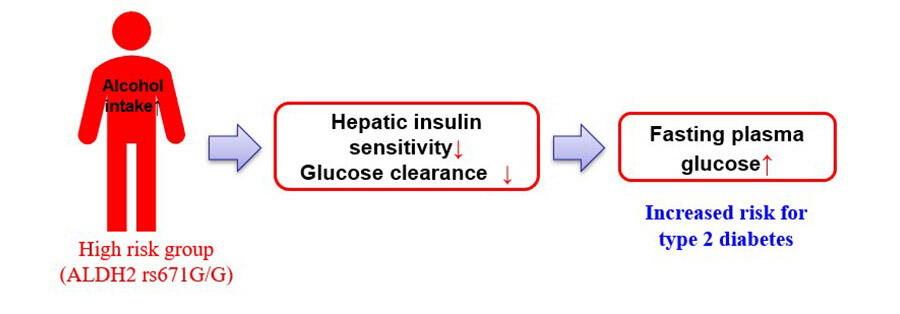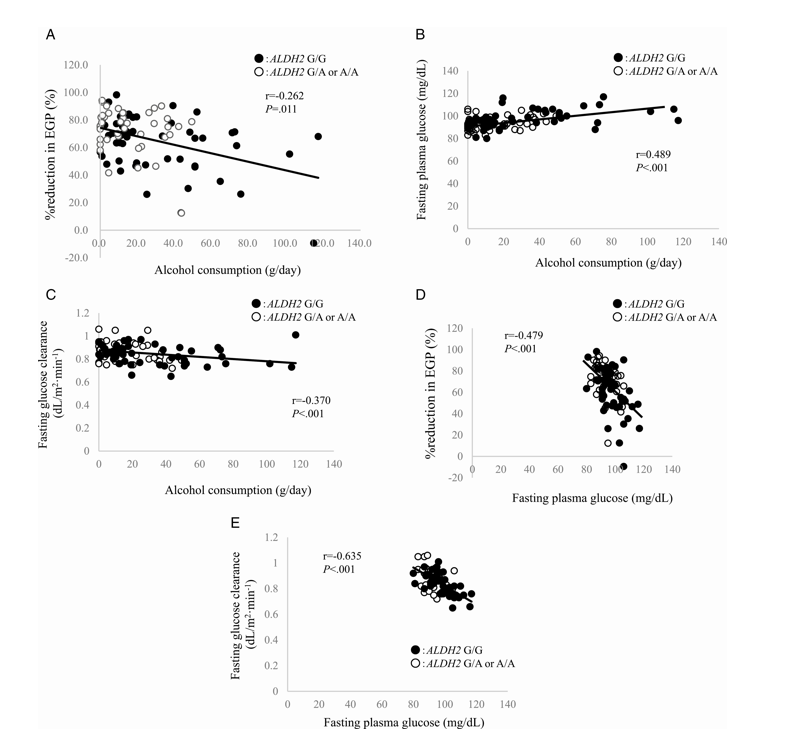The research group of Senior Associate Professor Yoshifumi Tamura, Specially appointed Professor Ryuzo Kawamori, Professor Hirotaka Watada, and others of the Departments of Metabolism & Endocrinology and the Center for Sportology at the Graduate School of Medicine, Juntendo University, studied 94 nonobese Japanese men to understand the mechanism by which people with a high tolerance for alcohol are more likely to develop diabetes. They successfully revealed for the first time that hepatic insulin may become less effective with an increase in the amount of alcohol consumed by people with a genotype that yields a high tolerance for alcohol, leading to elevated fasting blood glucose levels.
A genome-wide association study of 433,540 East Asian individuals was recently performed. It identified aldehyde dehydrogenase 2 (ALDH2) gene polymorphism (rs671), a genotype known to define tolerance to alcohol, in male type 2 diabetes individuals and reported that men with a genotype that imparts a high tolerance for alcohol are more likely to develop diabetes. However, the mechanism by which individuals with such a genotype are more likely to develop diabetes was still largely unknown.
To investigate further, the research group evaluated the relationship between ALDH2 gene polymorphism, and each parameter related to insulin sensitivity and metabolism in 94 nonobese Japanese men (with BMI within the normal range).
The results of the study showed that the high-risk group had consumed an average of 18.4 g of alcohol (about 370 mL of beer) per day, which was about 1.5 times higher than 12.1 g (about 240 mL of beer) consumed by the low-risk group, despite no significant difference in body fat mass, liver fat mass, and liver function between the two groups. However, the high-risk group was shown to have a fasting blood glucose level of 97.5±7.9 mg/dL, which was significantly higher than 93.5±6.2 mg/dL of the low-risk group. Therefore, individuals from the high-risk group, although they were not obese, were found to consume a large amount of alcohol and have high fasting blood glucose levels.

Credit: Juntendo University

Credit: J Clin Endocrinol Metab, dgab324, https://doi.org/10.1210/clinem/dgab324
Senior Associate Professor Tamura says, "We have previously shown that a week of abstinence in men with drinking habits improves hepatic insulin resistance and lowers fasting blood glucose levels. The results of this study also suggest that proper management of alcohol consumption is effective in preventing diabetes. High tolerance for alcohol does not mean that it is okay to drink a lot of alcohol, and people with a high tolerance for alcohol need to pay particular attention to the amount of alcohol they drink."
■ ALDH2 (aldehyde dehydrogenase 2) gene polymorphism (rs671)
Alcohol consumed by humans is decomposed into acetaldehyde, which is then decomposed and detoxified into acetic acid mainly by ALDH2 in the liver.
Most Caucasians (99%) have a type of ALDH2 that imparts high tolerance for alcohol (rs671G/G). This type of ALDH2 is present in only about 50% of Asians, including Japanese.
Therefore, the effects of alcohol on human health have been shown to differ depending on the type of disease, race, and even gene.
You can easily find your own ALDH2 genotype using an ethanol patch test.
This article has been translated by JST with permission from The Science News Ltd.(https://sci-news.co.jp/). Unauthorized reproduction of the article and photographs is prohibited.




